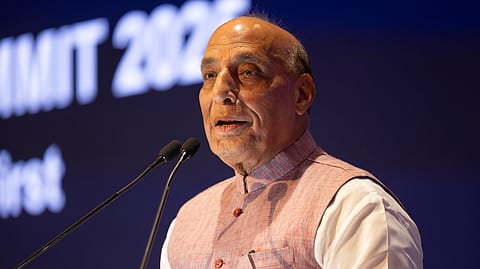‘Make in India’ played a key role during Operation Sindoor: Rajnath Singh
The strength of a nation is not evaluated just by its GDP, foreign investment or export figures, it also depends on the confidence a country can inspire in its citizens and the global community, says Rajnath Singh.

Make in India’ is an essential component in the country’s national security and it played a key role in India’s effective action against terrorism during Operation Sindoor, Defence Minister Rajnath Singh told industry captains at the Annual Business Summit 2025 organised by the Confederation of Indian Industry (CII).
Singh emphasised that through the Advanced Medium Combat Aircraft (AMCA) programme execution model, the private sector will get an opportunity to participate in a mega defence project along with public sector companies for the first time, further bolstering indigenous defence capabilities.
The defence minister termed the execution model for AMCA programme to build fifth generation fighter aircraft in India as a bold and decisive step, which will take the domestic aerospace sector to greater heights. “Under the AMCA project, the plan is to develop five prototypes, which will be followed by series production. It is a key milepost in the history of the Make-in-India programme,” he said.
Highlighting the success of ‘Make in India’ during Operation Sindoor, Singh stated that the Indian Armed Forces would not have been able to take effective action against terrorism in Pakistan and Pakistan-Occupied Kashmir (PoK) if the nation had not strengthened its indigenous defence capabilities. He described ‘Make in India’ as crucial for security and prosperity, stating that the use of indigenous systems during Operation Sindoor has proved that India has the power to penetrate any armour of the enemy. “We destroyed the terrorist hideouts and then the military bases. We could have done a lot more, but we presented a great example of coordination of power and restraint,” he said.
Dubbing the Indian industry as the carrier of the collective aspirations of the nation, the defence minister said that only the common efforts and synergy of the government and the industry can make India a developed nation by 2047.
Singh stressed that, in today’s times, the strength of a nation is not evaluated just by its economic index like GDP, foreign investment or export figures, it also depends on the confidence a country can inspire in its citizens and the global community. “Trust lasts only when a country has the confidence that it can protect its geopolitical interests, ensure the safety of its citizens, and remain stable in the face of future uncertainties. The morale of the nation remains high only when it knows that its today is secure, and tomorrow is safe,” he added.
The defence minister emphasised that the government has given priority to policy clarity, indigenisation, economic resilience and strategic autonomy, and the success of these efforts can be ensured only when all the stakeholders, including innovators, entrepreneurs & manufacturers become strong partners in this national mission. He exhorted the Indian industry to focus on national interests, more than company interests. “If securing company interests is your karma, safeguarding national interests is your dharma,” he said.
Recommended Stories
“India is not just a consumer of defence technology, but has also become a producer and exporter. When the world approaches us for high-end defence systems, it is not just a market indication, it is a respect for our capability,” he added.
Singh highlighted the important role being played by the defence sector in India’s growth journey by enumerating the feats achieved due to the initiatives taken by the government in the last decade. “10-11 years ago, our defence production was around ₹43,000 crore. Today, it has crossed the record figure of ₹1,46,000 crore, with a contribution of over ₹32,000 crore by the private sector. Our defence exports, which were around ₹600-700 crore 10 years ago, have surpassed a record figure of ₹24,000 crore today. Our weapons, systems, sub-systems, components, and services are reaching around 100 countries. Over 16,000 MSMEs, associated with the defence sector, have become the backbone of the supply chain. These companies are not only strengthening our self-reliance journey, but are also providing employment to lakhs of people,” he said.
The defence minister said that India is not only producing fighter aircraft and missile systems, it is also getting ready for new-age warfare technology. “We are continuously making headway even in frontier technologies. Our progress in the field of Artificial Intelligence, Cyber Defence, Unmanned Systems, and Space-Based Security is being recognised on the global stage. India has the potential to become a development hub for engineering, high precision manufacturing and future technologies,” he said.